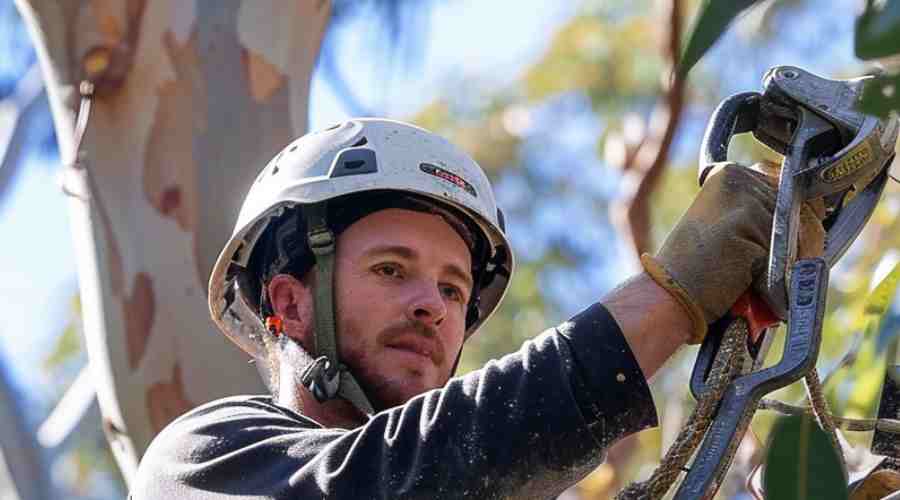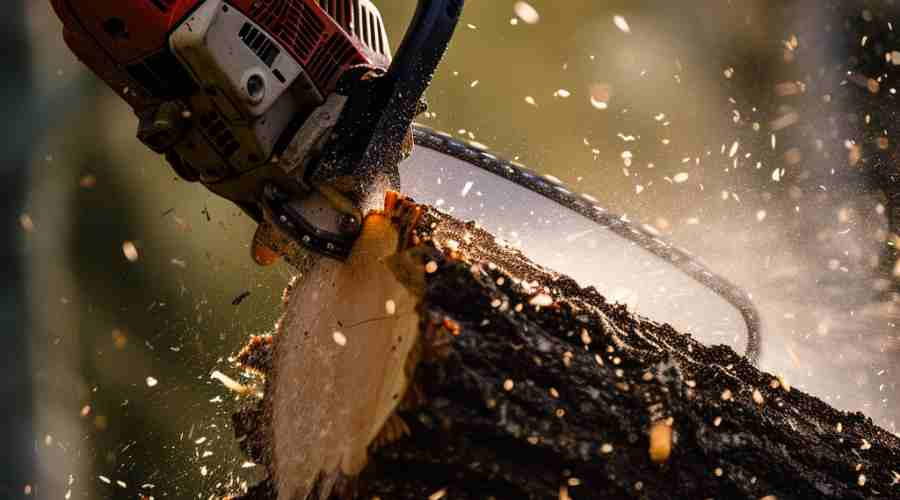Tree Removal Safety Guide
Staying Safe When Removing Trees
Removing trees, especially large trees, can be an extremely dangerous job if proper safety precautions are not taken. From falling branches to power lines to uneven ground, many hazards exist when taking down trees. By following some key safety techniques and using the right protective gear, tree removal can be done safely.
Why Tree Removal Safety is Critical
Tree removal injuries, and even deaths, occur every year from preventable accidents. Key reasons safety must be a top priority:
- Falling trees and branches can crush structures, vehicles, and people if not properly controlled. A small branch weighs much more than you’d think.
- Power lines run through and around many trees and contacting a live wire can cause electrocution.
- Tools like chainsaws are dangerous. Kickback from cutting too quickly causes severe cuts.
- Working at heights on ladders, in bucket trucks, and climbing trees leads to dangerous falls.
- Uneven ground, debris, and unseen holes can lead to trips and falls while working.
By following a safety-first approach, using safety gear, establishing a drop zone, and getting proper training, tree removal risks are greatly reduced. It’s also important homeowners partner with licensed and insured tree companies to ensure safety rules are followed.
Essential Tree Removal Safety Techniques
1. Inspect the Area Thoroughly
Before starting any cut, carefully inspect the tree, surrounding land, and airspace. Look for:
- Power Lines: Keep at least 10 feet between tree parts and any power lines. Contact the utility company to discuss safety if lines run through the tree. They may need to disconnect power before removal.
- Structures & Property: Check for any risks like nearby homes, vehicles, or other valuables that falling trunks or branches could damage. Establish a clear drop zone away from these.
- Ground Firmness: Walk the area checking for holes, uneven ground, rocks, roots, or debris that could trip workers. Address these hazards first.
- People, Plants & Pets: Ensure no one is within range of falling debris. Also check for gardens, landscaping or pets that could be damaged and restrict access.
- Other Trees: Trees being removed can take down healthy nearby trees too. Check for any entanglement risks and address before cutting.
2. Use Proper Safety Gear & Clothing
Tree removal crews must wear appropriate clothing and protective equipment. Required gear includes:
- Hard Hat: Helps prevent head injuries from falling branches and tools like chainsaws that can kick back. Hard hats meeting ANSI Z89.1 safety standards offer robust impact protection.
- Safety Glasses: Prevent eye injuries and sawdust irritation. Wraparound glasses provide added protection.
- Hearing Protection: Chainsaws, chippers and stump grinders create loud noise. Earmuffs or earplugs prevent hearing damage.
- High Visibility Vest: Allows crew members to see each other clearly when hauling off branches or controlling drop zones.
- Steel-Toe Boots: Protect feet from sharp tools, falling limbs and prevent ankle injuries on uneven ground. Boots with non-slip soles provide added traction.
- Gloves: Different gloves serve different purposes – leather for handling branches, rubber for grip and cut resistance when running chainsaws.
3. Handle Tools Safely
Most tree removal injuries involve portable power tools, especially chainsaws which require full attention when operating:
- Wear proper PPE like chaps, safety boots, gloves and eye protection when running a chainsaw.
- Use two hands firmly grip the chainsaw handles for maximum control.
- Maintain solid footing and only cut at shoulder height or below so you can control unexpected kickback forces.
- Take frequent breaks as chainsaw operation leads to fatigue which causes accidents.
- Ensure saw chain is properly sharpened, has correct tension and all guards are in place before starting any cut.
Similar safety rules apply for other power tools like chippers and stump grinders – maintain control, ensure guards are in place, disconnect before servicing or adjusting.
4. Establish a Drop Zone
Before starting the removal, establish a clear drop zone for the parts of the tree to fall into. The drop zone should:
- Be at least twice as large as the height of the tree. For example, a 40 ft tree needs an 80 ft drop zone.
- Be completely clear of people, animals, buildings, vehicles and other valuables.
- Have solid, flat ground. Avoid slopes more than 10 degrees or drop zones near holes, ditches, or embankments.
- Allow workers room to safely retreat once tree begins falling.
- Often a 30 degree wedge drop zone works well to guide falling trunks and branches.
Use signage, cones, fencing, spotters and more to secure the drop zone. Test smaller branches first to ensure the trunk leans as planned before making major cuts.
5. Make Proper Cuts
Using proper tree felling techniques is critical for safety and an orderly removal process:
- Notch Cuts: Make a notch one-third into the trunk on the intended fall direction. This notch guides the tree’s descent.
- Hinge Wood: Leave an uncut section of trunk opposite the notch called the hinge. This flexible wood controls the tree as it falls.
- Felling Back Cut: After the notch is made, cut on the opposite side until tree begins falling, while maintaining enough hinge wood.
- Wedge Cuts: If tree does not fall completely, use plastic or wood wedges to direct its descent.
Finish cutting the hinge wood after tree hits ground to lower its center of gravity during dismantling. Always use two escape routes when trees start to fall.
6. Lower Large Sections Carefully
Once on the ground, carefully disassemble and lower large trunk or branch sections to avoid crushing injuries:
- Judge weight and pivot points before rigging or moving wood sections. Get help moving very heavy pieces.
- Make shallow notch cuts then roll/pivot sections slowly and carefully.
- Use ropes, chains and machinery like cranes or bucket trucks to lower large sections under control.
- If limbs are spring-loaded or compressed, make small release cuts then retreat quickly as pieces can kick out with tremendous energy.
Go slow when handling large wood on the ground, wear PPE and avoid being underneath unsupported pieces high off the ground.
Frequently Asked Questions
What is a drop zone in tree removal?
A drop zone is a clearly marked-off area around the tree where cut sections can fall safely to the ground without hitting people, buildings, vehicles or causing other damage. Drop zones must be a minimum of twice the total tree height in size and completely secure before cutting begins.
Do I need a permit to remove trees?
Most areas require permits or permission for removing trees over a certain size, even on private residential property. Research local regulations as fines for illegal tree removal can be substantial. Permits help ensure proper planning goes into the removal – like notifying underground utility companies before digging out a stump or identifying protected tree species.
Conclusion
Tree removal brings serious risks, but safe techniques allow the work to be completed securely. Always exercise extreme caution with electrical hazards, unstable wood sections aloft, heavy machinery and when operating dangerous cutting tools. By surveying the site, wearing proper PPE gear, establishing a suitable drop zone and making careful cuts, tree removal crews can accomplish their work incident-free. Partnering with professional insured services brings added assurance proper methods are used. With safety as the utmost priority throughout, trees can be taken down efficiently despite the inherent hazards.


